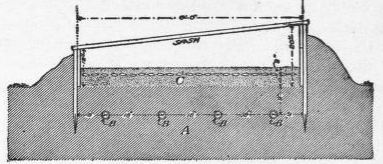630. Propagation Of Sweet Potato
Description
This section is from the book "Vegetable Gardening", by Ralph L. Watts. Also available from Amazon: Vegetable Gardening.
630. Propagation Of Sweet Potato
Sweet potatoes are usually propagated by means of "slips," also known as "sets" and "draws." The tubers are first bedded in fine soil, with proper heat and moisture. The potatoes sprout and produce rooted plants, which are removed and planted in the field after all danger of frost has passed.
Ordinary hotbeds are often used in propagating the plants. The amount of manure required depends upon the locality. A depth of 1 foot of fresh manure is usually sufficient. The soil is not added until the bed has begun to heat.
In some sections through the northern area of the sweet potato district flue-heated beds are employed. These are very common in New Jersey. Figure 101 shows such a structure with the canvas covering removed. The canvas is kept over the beds during the early stages of rooting and removed later when weather conditions permit, but replaced in cold or frosty weather. The flues may be built of wood, tile, concrete or brick. The walls of the bed are of any desired construction, and frequently sash are used for covering instead of canvas.
Pipe-heated beds are popular in some sections. Beat-tie (U. S. D. A. Farmers' Bul. 324, p. 12) gives the following description of this method: "Where a steam or hot water boiler is in use for greenhouse or residence heating, a very satisfactory plant bed can be constructed by burying four or five lines of pipes in the soil beneath the bed and supplying the heat from the boiler. This has been found to be an ideal method, as the lines of pipes can be controlled by valves and the temperature of the soil in the bed kept at the desired point. If hot water heat is used the pipes should be laid with the soil in direct contact with them, but for steam the pipes should be surrounded with 3-inch or 4-inch tiles to prevent too rapid passage of the heat and the consequent burning of the soil. The pipes should be placed 10 or 12 inches below the bottom of the special soil in the bed, and 14 to 16 inches below the line of the seed potatoes. If the pipes are laid 18 inches apart, an even distribution of heat will be secured. For hot water heating, 2-inch pipes should be employed, but 1 1/4-inch pipes will be large enough for steam, provided the lines are not more than 60 feet in length. The lines of pipe should be carefully graded and have a uniform fall toward the return end; in fact, the rules governing greenhouse heating apply to the piping of beds of this kind. A general idea of the construction of a pipe-heated bed may be gained from the cross section shown as Figure 102.

Fig. 102. cross-section of pipe-heated frame.
In the far South it is not necessary to provide any kind of protection to the seed bed. In the North, protection with glass or canvas will serve the purpose without artificial heating.
Any fine, light, sandy soil may be used for bedding the potatoes. First, there should be several inches of soil in the bed and the upper inch free from all coarse materials. Then the tubers are placed, by hand, on the surface of the bed so that they do not touch each other. Very large potatoes may be split lengthwise, the cut surfaces' being placed next to the sand. After placing tubers, cover them with about 3 inches of fine soil and then water thoroughly.
At the time of bedding the temperature of the bed should range from 80 to 85 degrees and be gradually dropped during a period of six weeks, perhaps, to about 60 degrees, when the plants may be set in the field if weather conditions are suitable. The air temperature in the frame should never fall below 60, and higher temperatures are preferred for some time after the tubers have been bedded. Watering and ventilation must be attended as changing weather conditions demand. Flue or steam-heated frames require more frequent and abundant watering than manure-heated and nonheated beds. Strong, healthy plants are essential to large yields, but good plants cannot be grown without close, daily attention.
In the extreme South the tubers are sometimes cut into pieces and planted like white potatoes, and again the small tubers are occasionally planted whole and cuttings made to extend the plantation. Vine cuttings are commonly used in the most favorable regions. They are usually 10 or 12 inches long, and are made after the plants begin to vine. When planted, they are placed horizontally or obliquely with only 1 or 2 inches of the tip projecting above ground.
631. Soil Preparation
Weeds must be guarded against by clean cultivation, in making preparations for a crop of sweet potatoes. Rotation is important. A thoroughly cultivated crop, followed by crimson clover, puts the soil in excellent condition for planting sweet potatoes. In sections where climatic conditions permit, it is customary to grow an early crop of peas, beans, cabbage or other vegetables before planting sweet potatoes. While a comparatively dry soil is essential to this crop, the supply of moisture must be ample at transplanting, a fact which must always be kept in mind in all preparatory tillage operations.
Continue to:
Tags
plants, crops, gardening, cultivated, harvesting, food ,greenhouses, fertiliser, vegitables
